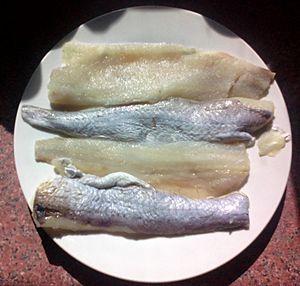Southern blue whiting facts for kids
Quick facts for kids Southern blue whiting |
|
|---|---|
 |
|
| Drawing by Dr Tony Ayling | |
| Scientific classification |
The southern blue whiting (Micromesistius australis) is a type of codfish. It belongs to the same family as cod and haddock. This fish lives in the southern parts of the world's oceans. It prefers cold water, usually between 3 and 7 degrees Celsius. You can find it deep underwater, from about 50 meters to 900 meters down.
Southern blue whiting usually grow to be about 30 to 60 centimeters long. That's about the length of a school ruler! Some can even grow up to 90 centimeters, which is almost a meter. The heaviest ones can weigh at least 1350 grams, or about 1.35 kilograms.
Contents
About Southern Blue Whiting
The southern blue whiting has a close relative called the blue whiting. This other fish lives in the northern parts of the world.
In Canada, the southern blue whiting is sometimes called "blue cod." This is allowed by their food rules. It's a well-known fish that belongs to the Gadidae family, which includes many popular fish like cod.
A Tasty Fish
Southern blue whiting is a very useful fish for cooking. People often cut it into fillets, which are pieces of fish without bones. These fillets are commonly served breaded or battered, like in fish and chips. You can also pan-fry, oven-bake, or steam this fish. It has white, flaky meat and a mild taste. This makes it popular with both kids and adults.
Where Southern Blue Whiting Live
Southern blue whiting live in two main areas, which are far apart. These are called "disjunct populations."
- One group, called M. a. australis, lives around the Falkland Islands and Argentine Patagonia. You can also find them off Chile and near islands like South Georgia, South Shetland, and South Orkney Islands.
- The other group, called M. a. pallidus, lives around the South Island of New Zealand. Scientists think there might be several smaller groups of southern blue whiting in this area.
Catching Southern Blue Whiting
Most southern blue whiting are caught near New Zealand. Large numbers of them live around places like the Bounty Platform and Campbell Island Rise. Fishers mainly catch them using large nets called mid-water and semi-pelagic trawl nets. These nets are pulled through the water behind fishing boats.
Sustainable Fishing
The southern blue whiting fisheries in New Zealand were the first "blue whiting" fisheries in the world to get a special award. This award is called the Marine Stewardship Council (MSC) certification. It's like a "gold standard" for fishing. It means that the fish are caught in a way that is good for the ocean and makes sure there will be enough fish for the future.
See also
 In Spanish: Bacaladilla para niños
In Spanish: Bacaladilla para niños


